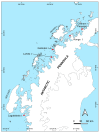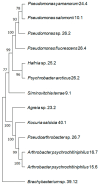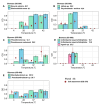Endophytic Bacterial Biofilm-Formers Associated with Antarctic Vascular Plants
- PMID: 39458248
- PMCID: PMC11509575
- DOI: 10.3390/microorganisms12101938
Endophytic Bacterial Biofilm-Formers Associated with Antarctic Vascular Plants
Abstract
Deschampsia antarctica and Colobantus quitensis are the only two vascular plants colonized on the Antarctic continent, which is usually exposed to extreme environments. Endophytic bacteria residing within plant tissues can exhibit diverse adaptations that contribute to their ecological success and potential benefits for their plant hosts. This study aimed to characterize 12 endophytic bacterial strains isolated from these plants, focusing on their ecological adaptations and functional roles like plant growth promotion, antifungal activities, tolerance to salt and low-carbon environments, wide temperature range, and biofilm formation. Using 16S rRNA sequencing, we identified several strains, including novel species like Hafnia and Agreia. Many strains exhibited nitrogen-fixing ability, phosphate solubilization, ammonia, and IAA production, potentially benefiting their hosts. Additionally, halotolerance and carbon oligotrophy were also shown by studied bacteria. While some Antarctic bacteria remain strictly psychrophilic, others demonstrate a remarkable ability to tolerate a wider range of temperatures, suggesting that they have acquired mechanisms to cope with fluctuations in environmental temperature and developed adaptations to survive in intermediate hosts like mammals and/or birds. Such adaptations and high plasticity of metabolism of Antarctic endophytic bacteria provide a foundation for research and development of new promising products or mechanisms for use in agriculture and technology.
Keywords: Colobantus quitensis (Kunth) Bartl; Deschampsia antarctica Desv.; PGPB; amyloids; bacterial endophytes; biofilm; plant–microbial interactions.
Conflict of interest statement
The authors declare no conflict of interest.
Figures







Similar articles
-
Root-Associated Bacteria Community Characteristics of Antarctic Plants: Deschampsia antarctica and Colobanthus quitensis-a Comparison.Microb Ecol. 2022 Oct;84(3):808-820. doi: 10.1007/s00248-021-01891-9. Epub 2021 Oct 18. Microb Ecol. 2022. PMID: 34661728 Free PMC article.
-
Root endophytic Penicillium promotes growth of Antarctic vascular plants by enhancing nitrogen mineralization.Extremophiles. 2020 Sep;24(5):721-732. doi: 10.1007/s00792-020-01189-7. Epub 2020 Jul 22. Extremophiles. 2020. PMID: 32699913
-
Are Deschampsia antarctica Desv. and Colobanthus quitensis (Kunth) Bartl. migratory relicts?Tsitol Genet. 2007 Jul-Aug;41(4):36-40. Tsitol Genet. 2007. PMID: 18030724
-
Drought tolerance improvement in plants: an endophytic bacterial approach.Appl Microbiol Biotechnol. 2019 Sep;103(18):7385-7397. doi: 10.1007/s00253-019-10045-4. Epub 2019 Aug 2. Appl Microbiol Biotechnol. 2019. PMID: 31375881 Review.
-
Ecophysiology of Antarctic Vascular Plants: An Update on the Extreme Environment Resistance Mechanisms and Their Importance in Facing Climate Change.Plants (Basel). 2024 Feb 3;13(3):449. doi: 10.3390/plants13030449. Plants (Basel). 2024. PMID: 38337983 Free PMC article. Review.
References
-
- Parnikoza I., Kozeretska I., Kunakh V. Vascular plants of the Maritime Antarctic: Origin and adaptation. Am. J. Plant Sci. 2011;2:381. doi: 10.4236/ajps.2011.23044. - DOI
-
- Gallardo-Cerda J., Levihuan J., Lavín P., Oses R., Atala C., Torres-Díaz C., Molina-Montenegro M.A. Antarctic rhizobacteria improve salt tolerance and physiological performance of the Antarctic vascular plants. Polar Biol. 2018;41:1973–1982. doi: 10.1007/s00300-018-2336-z. - DOI
LinkOut - more resources
Full Text Sources

